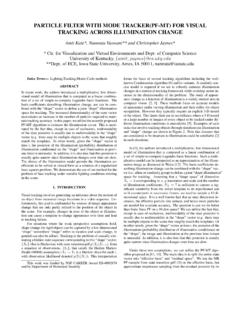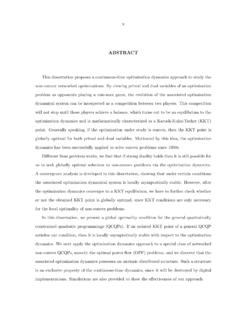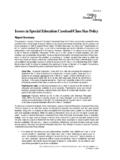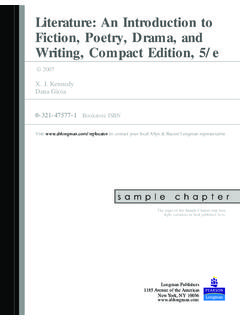Transcription of 1 Quantification of Secrecy in Partially Observed ...
1 1 Quantification of Secrecy in Partially ObservedStochastic discrete Event SystemsJun Chen ,Member, IEEE, Mariam Ibrahim and Ratnesh Kumar,Fellow, IEEEA bstract While cryptography is used to protect the content ofinformation ( , a message) by making it undecipherable, behav-iors (as opposed to information) may not be encrypted, and mayonly be protected by Partially or fully hiding through creationof ambiguity by providing covers that generate indistinguishableobservations from secrets. Having a cover together with partialobservability does cause ambiguity about the system behaviorsto be kept secret, yet some information about secrets may stillbe leaked due to statistical difference between the occurrenceprobabilities of the secrets and their covers.
2 In this paper, wepropose a Jensen-Shannon divergence (JSD) based measure toquantify Secrecy loss in systems modeled as Partially -observedstochastic discrete event systems ( stochastic PODES), whichquantifies the statistical difference between two distributions, oneover the observations generated by secret and the other overthose generated by cover. We further show that the proposed JSDmeasure for Secrecy loss is equivalent to the mutual informationbetween the distribution over possible observations and that overpossible system status (secret versus cover). Since an adversary islikely to discriminate more if he/she observes for a longer period,our goal is to evaluate the worst-case loss of Secrecy as obtainedin limit over longer and longer observations.
3 Computation for theproposed measure is also presented. Illustrative examples, includ-ing one with side channel attack, are provided to demonstratethe proposed computation to Practitioners Secrecy is the ability to hide privateinformation. Forcommunicated information, this can be donethrough encryption or access control. But the same is not doablefor systembehaviors, and in contrast, cover is introduced forproviding ambiguity. Quantifying the ability to hide secrets is achallenge. This paper provides a means to quantify this in termsof a type of distance measure between a secret and its cover.
4 Acomputation of the same is also provided for Partially -observedstochastic discrete event systems, and illustrated through a cache sside-channel Secrecy loss discrete event systems (DES), stochastic systems,partial observability, Jensen-Shannon divergence (JSD), research was supported in part by PNNL and John Deere throughNSF-IUCRC, Security and Software Engineering Research Center (S2 ERC),and the National Science Foundation under the grants NSF-ECCS-0926029and Chen and Ratnesh Kumar are with the Department of Electrical andComputer Engineering, Iowa State University, Ames IA 50011 USA Jun Chen has moved to IdahoNational Laboratory since November Ibrahim is with the Department of Electrical and Computer Engi-neering, Iowa State University, Ames IA 50011 USA, and the Department ofMechatronics Engineering, German Jordan University, Amman 11180 Jordan(email.)
5 Jun Chen and Mariam Ibrahim are equal contributors, with their nameslisted in alphabetic rapid progress in information and communication tech-nology has made it possible for an adversary to eavesdropand/or attack confidential or private communication. Whilecryptography is used to protect the content of information( , a message) by making it undecipherable, the sametechnique may not be used to hide behaviors which may notbe encrypted. In such cases,secrecycan instead be attainedthrough creation of ambiguity, caused for example by partialobservation that ambiguates secrets from covers, where thesecrets are system behaviors desired to be kept confidential,whereas the covers are the complementary system behaviorsthat generate the same observations as the secrets, creatingambiguity.
6 Researchers in the field of security and privacyhave explored many techniques for hiding secrets based onambiguation schemes such as,Steganography and Watermark-ing[1], [2],Network level Anonymization[3], andSoftwareObfuscation[4].Various notions of information Secrecy have been exploredin literature. References [5] [7] defined the non-interferencefor input-output systems as a property in which the outputs thatare observable to anadversaryshould not depend on anysecretinput so that the adversary does not deduce anything aboutthe secret input by observing the output. Non-interference is alogical notion that is either satisfied or violated, and as suchit does not allow the quantification of the degree to whicha system may violate the property.
7 Accordingly, the notionis enriched for probabilistic systems for which the degreeof interference can be quantified in terms of the amount ofinformation leaked by a system to an observer. The amount ofinformation leakage, in turn, is measured by the loss of uncer-tainty about the inputs due to the observation of the outputs, , the difference between the prior and posterior entropiesof the inputs, namely the mutual information between inputsand outputs [5]. While such a quantification of informationleakage is satisfactory for long periods of system operation(since entropy measures uncertainty in an average sense), itis of limited use for systems in which an adversary makes asingle observation.
8 To address this situation, the average casemeasure of entropy was replaced by its best case measurecorresponding to minimum uncertainty, namelymin-entropy,in the definition of mutual information [7].In general, a secret can be a property of a sequence ofexecutions, and not just a single execution, and this generalsituation has also been examined in the literature. For examplein the setting of discrete event systems (DESs), the definitionof Secrecy examined in [8] requires that the execution ofbehaviors constituting a secret must be masked to an ob-2server through indistinguishable behaviors that are non-secret( , cover).
9 This is indeed analogous to the notion of non-interference, which by virtue of being logical has the samelimitation that it cannot quantify the degree to which a systemis interfering (or leaks information).For probabilistic DESs, where each discrete transition isassociated with a certain occurrence probability, more powerfulnotions of Secrecy can be defined. For example, [9] usedJensen-Shannon divergence between the distributions of asecret versus its cover as a way to quantify the Secrecy , whichis measured as the divergence of two distributions over theset of feasible observations, one being the probabilities ofsecret behaviors and the other being those of cover approximation algorithm for computing an upper boundof JSD was also provided in [9].
10 Another attempt to gen-eralize Secrecy from logical to stochastic DESs is providedin [10], where, alike the setting of mutual information basedcharacterization of information leakage, the authors considerthe difference between the prior and posterior distributions(before and after any observations) of the secret states, andrequire it to be upper bounded. The corresponding verificationproblem turns out to be undecidable. In another paper [11],the same authors proposed the notion ofStep-Based AlmostCurrent-State Opacityrequiring the probability of revealing thesecret must be upper bounded at each time step.
















